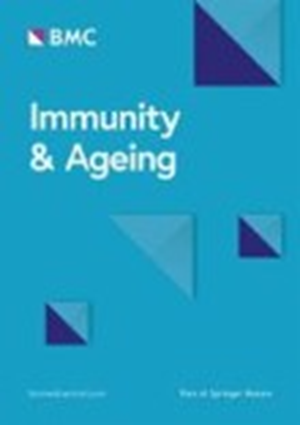肥胖、免疫衰老和胰岛素抵抗之间的相互作用
IF 5.2
2区 医学
Q1 GERIATRICS & GERONTOLOGY
引用次数: 0
摘要
肥胖是脂肪组织中脂肪的堆积,对人体健康有不利影响。与肥胖相关的新陈代谢失调与衰老过程中观察到的新陈代谢改变有相似之处。研究表明,肥胖者的脂肪细胞会发生细胞衰老,即所谓的衰老。衰老可通过一系列称为衰老相关分泌表型(SASP)的化学因子传递给其他正常细胞。这些因子大多是促炎化合物。免疫系统会清除这些衰老的 T 细胞,但免疫衰老(即免疫细胞的衰老)会破坏衰老 T 细胞的清除。免疫衰老是衰老的结果,或通过衰老组织的间接传播而发生。肥胖症中衰老的大量发生预计会导致免疫衰老,并损害免疫反应以解决炎症。持续的慢性炎症会破坏胰岛素在代谢组织中的代谢作用。因此,这篇综述重点探讨了衰老脂肪细胞在肥胖相关免疫衰老和随后的代谢失调中的作用。此外,文章还提出了针对衰老 T 细胞或使用衰老治疗药物来改善代谢综合征的新型治疗方法。本文章由计算机程序翻译,如有差异,请以英文原文为准。
The interplay between obesity, immunosenescence, and insulin resistance
Obesity, which is the accumulation of fat in adipose tissue, has adverse impacts on human health. Obesity-related metabolic dysregulation has similarities to the metabolic alterations observed in aging. It has been shown that the adipocytes of obese individuals undergo cellular aging, known as senescence. Senescence can be transmitted to other normal cells through a series of chemical factors referred to as the senescence-associated secretory phenotype (SASP). Most of these factors are pro-inflammatory compounds. The immune system removes these senescent T-cells, but immunosenescence, which is the senescence of immune cells, disrupts the clearance of senescent T-cells. Immunosenescence occurs as a result of aging or indirectly through transmission from senescent tissues. The significant occurrence of senescence in obesity is expected to cause immunosenescence and impairs the immune response to resolve inflammation. The sustained and chronic inflammation disrupts insulin's metabolic actions in metabolic tissues. Therefore, this review focuses on the role of senescent adipocyte cells in obesity-associated immunosenescence and subsequent metabolic dysregulation. Moreover, the article suggests novel therapeutic approaches to improve metabolic syndrome by targeting senescent T-cells or using senotherapeutics.
求助全文
通过发布文献求助,成功后即可免费获取论文全文。
去求助
来源期刊

Immunity & Ageing
GERIATRICS & GERONTOLOGY-IMMUNOLOGY
CiteScore
10.20
自引率
3.80%
发文量
55
期刊介绍:
Immunity & Ageing is a specialist open access journal that was first published in 2004. The journal focuses on the impact of ageing on immune systems, the influence of aged immune systems on organismal well-being and longevity, age-associated diseases with immune etiology, and potential immune interventions to increase health span. All articles published in Immunity & Ageing are indexed in the following databases: Biological Abstracts, BIOSIS, CAS, Citebase, DOAJ, Embase, Google Scholar, Journal Citation Reports/Science Edition, OAIster, PubMed, PubMed Central, Science Citation Index Expanded, SCImago, Scopus, SOCOLAR, and Zetoc.
 求助内容:
求助内容: 应助结果提醒方式:
应助结果提醒方式:


